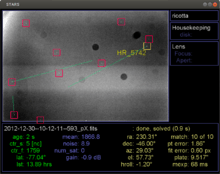Star tracker

A star tracker is an optical device that measures the position(s) of star(s) using photocell(s) or a camera.[1]
Many models[2][3][4] are currently available. Star trackers, which require high sensitivity, may become confused by sunlight reflected from the spacecraft, or by exhaust gas plumes from the spacecraft thrusters (either sunlight reflection or contamination of the star tracker window). Star trackers are also susceptible to a variety of errors (low spatial frequency, high spatial frequency, temporal, ...) in addition to a variety of optical sources of error (spherical aberration, chromatic aberration, etc.). There are also many potential sources of confusion for the star identification algorithm (planets, comets, supernovae, the bimodal character of the point spread function for adjacent stars, other nearby satellites, point-source light pollution from large cities on Earth, ...). There are roughly 57 bright navigational stars in common use. However, for more complex missions, entire star field databases are used to determine spacecraft orientation. A typical star catalog for high-fidelity attitude determination is originated from a standard base catalog (for example from the United States Naval Observatory) and then filtered to remove problematic stars, for example due to apparent magnitude variability, color index uncertainty, or a location within the Hertzsprung-Russell diagram implying unreliability. These types of star catalogs can have thousands of stars stored in memory on board the spacecraft, or else processed using tools at the ground station and then uploaded.
See also
References
- ↑ "Star Camera". NASA. May 2004. Archived from the original on July 21, 2011. Retrieved 25 May 2012.
- ↑ "Star Trackers". Goodrich. Archived from the original on May 17, 2008. Retrieved 25 May 2012.
- ↑ "Ball Aerospace star trackers". Ballaerospace.com. Retrieved 2013-09-09.
- ↑ "Attitude and Orbit Control Systems". Jena-optrinik.de. Retrieved 2013-09-09.